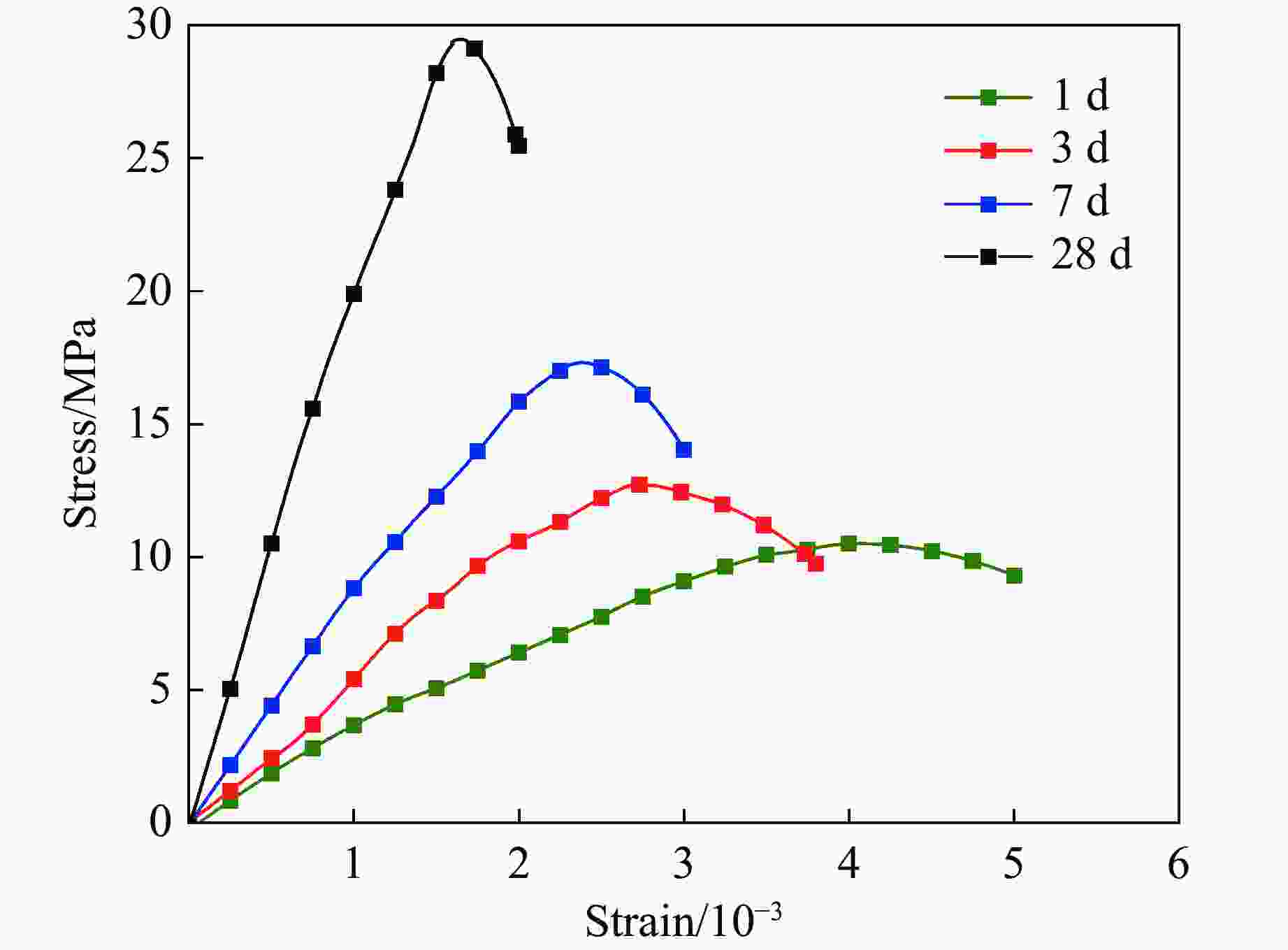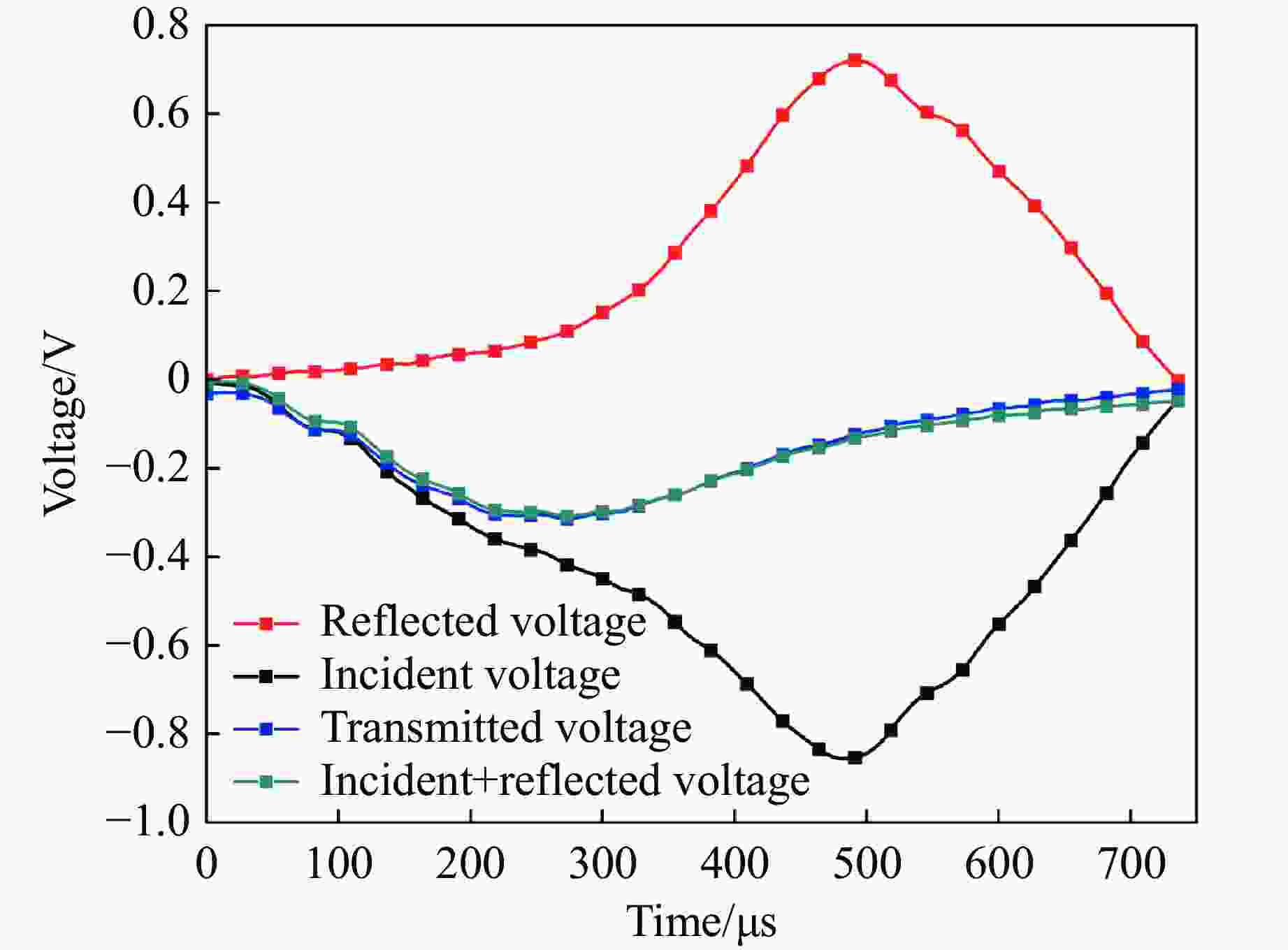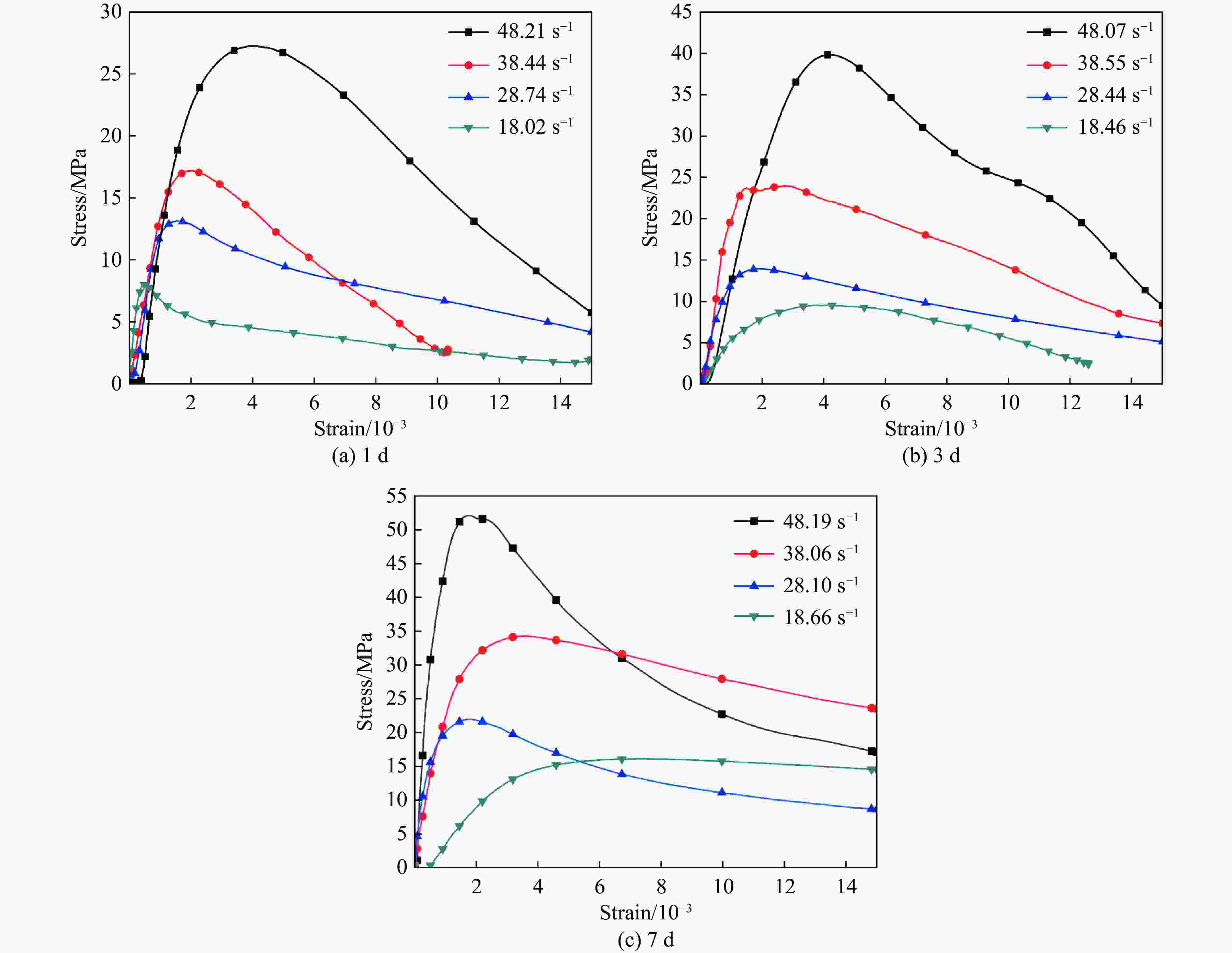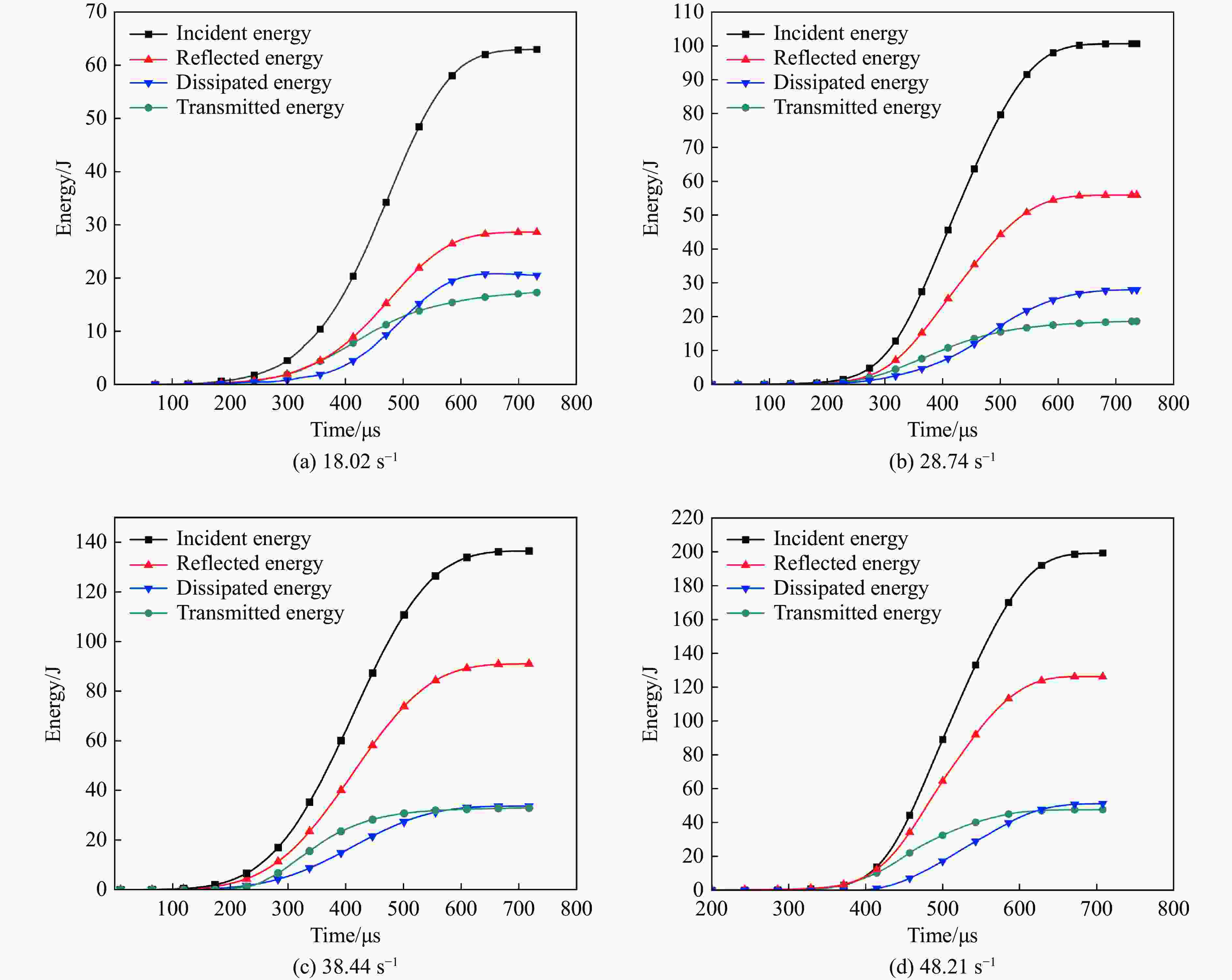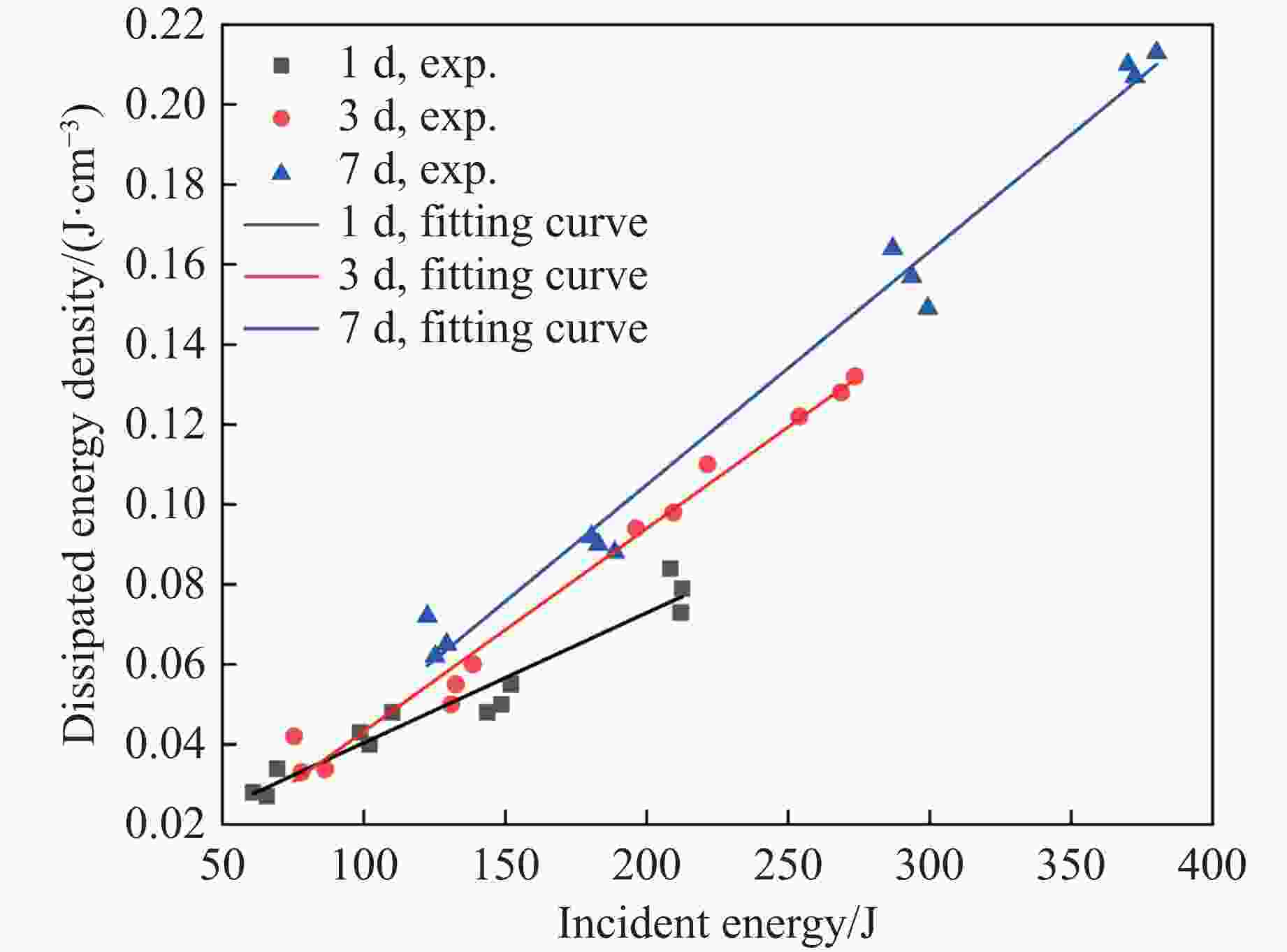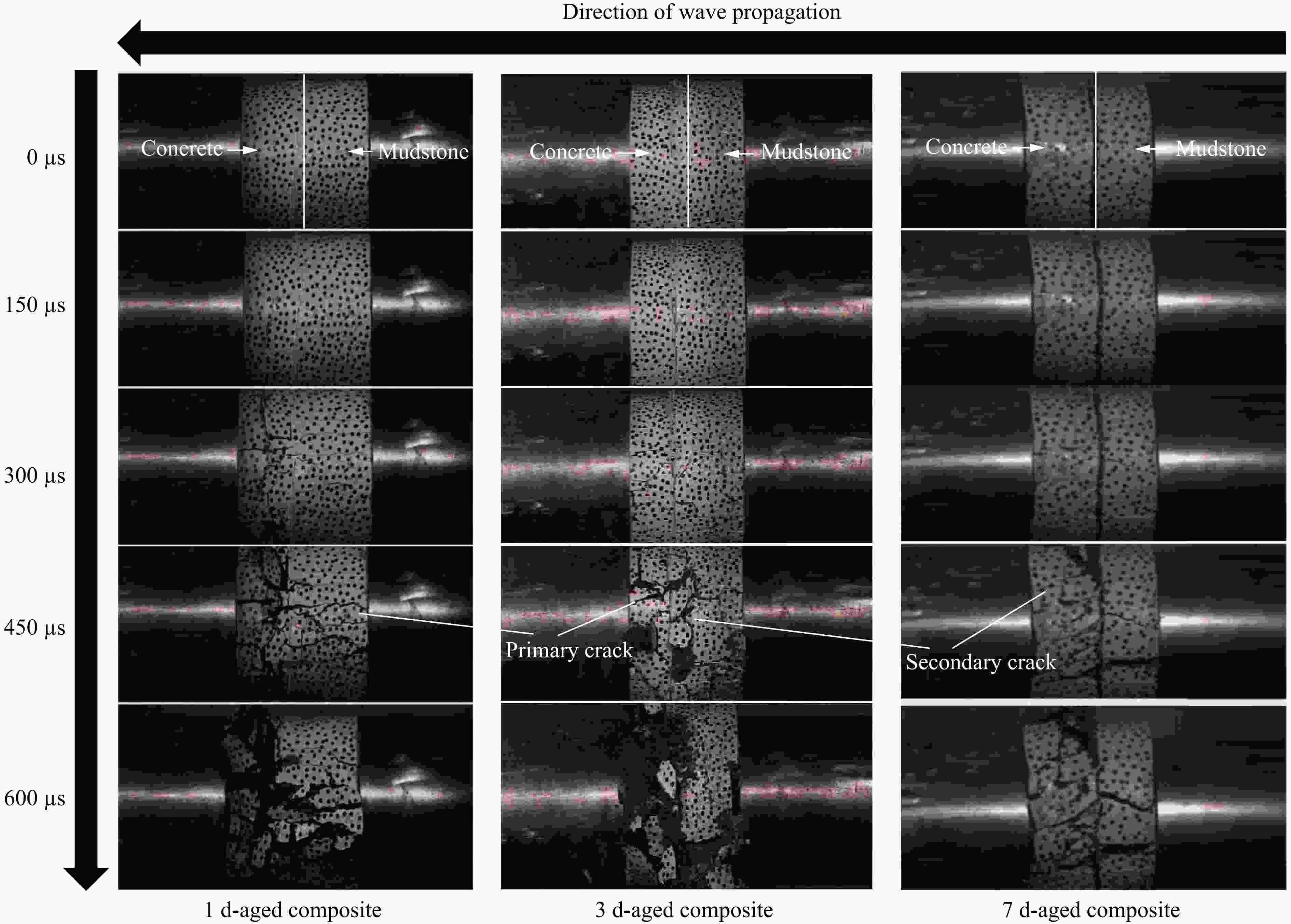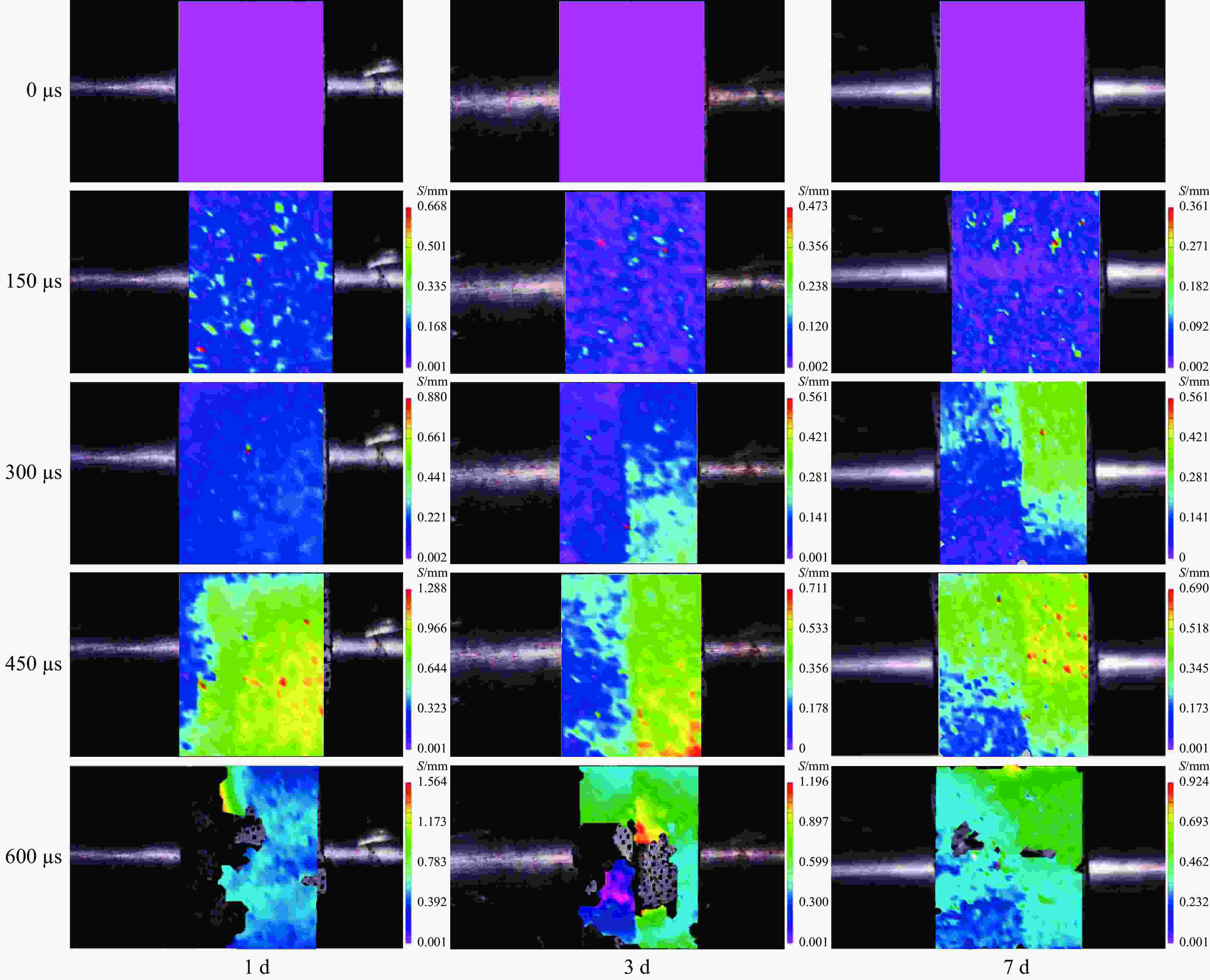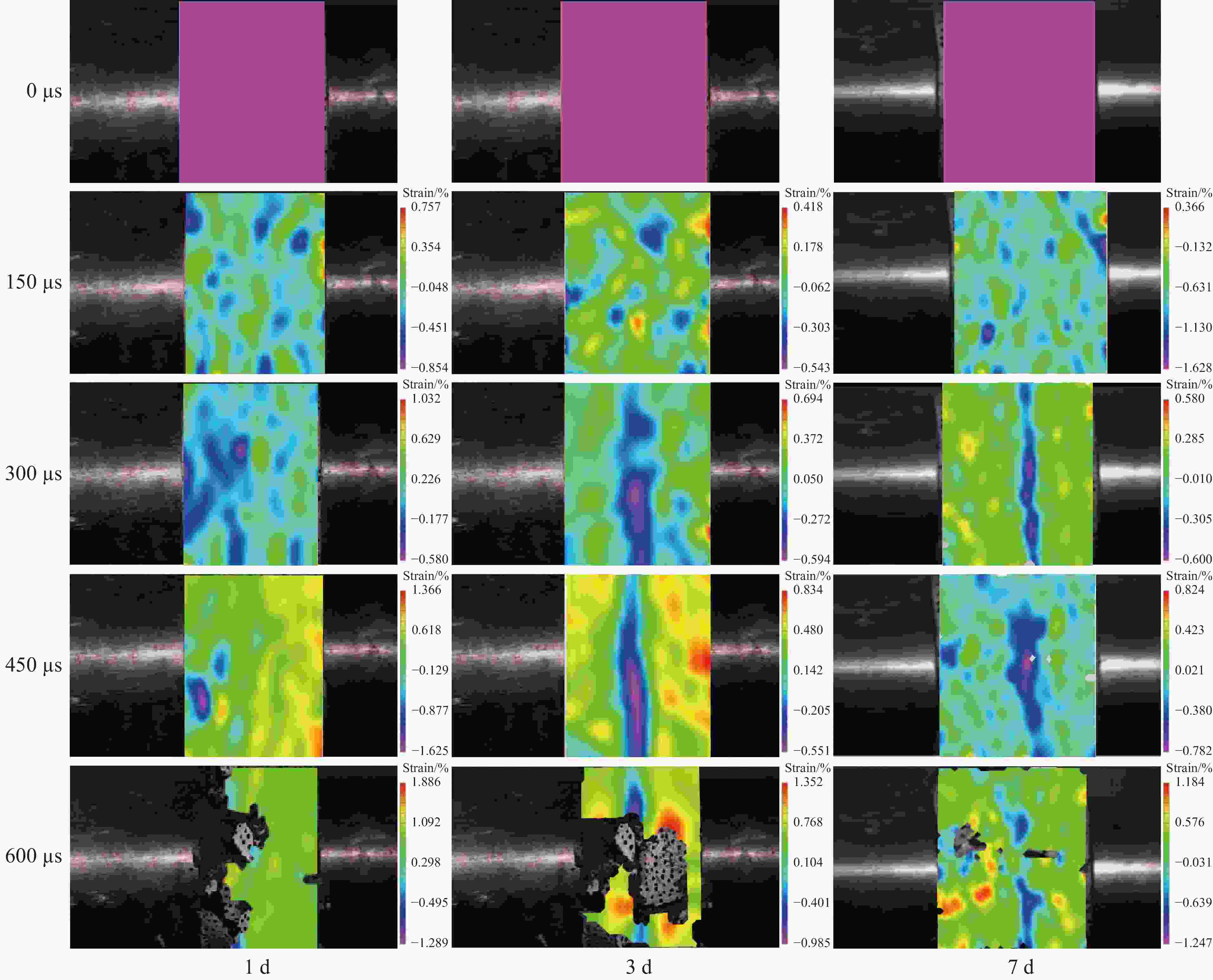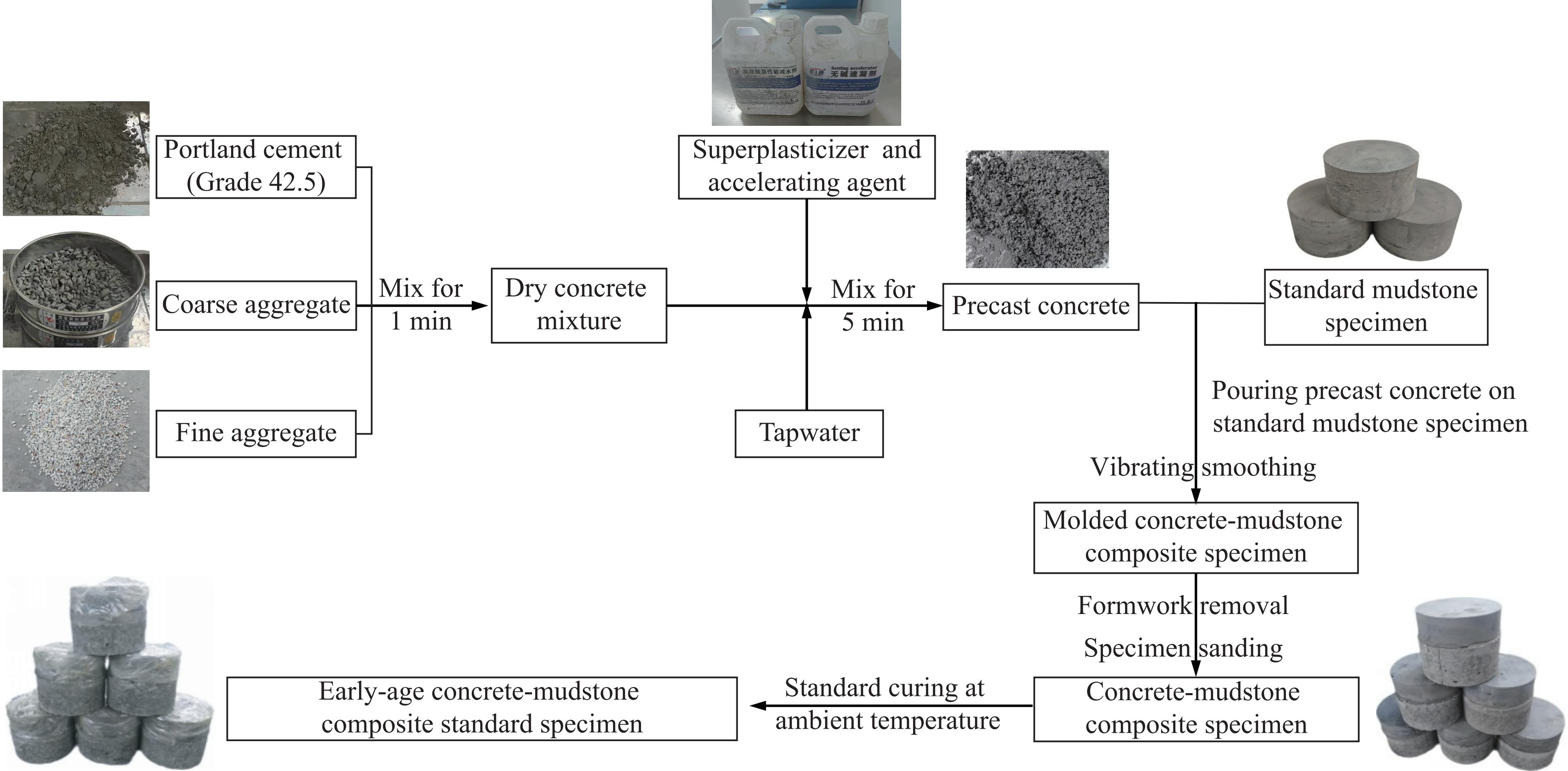Impact Dynamic Characteristics and Damage Features of Early-Age Concrete-Mudstone Composite
-
摘要: 为研究冲击荷载作用下早龄期混凝土-泥岩组合体的动态力学特性,采用分离式霍普金森压杆装置,结合高速摄影机,对养护龄期为1、3、7 d的组合体试件进行了冲击试验,基于数字图像相关(digital image correlation,DIC)技术分析了试件的位移场和应变场的演化规律,系统揭示了组合体的动态损伤破坏特征。试验结果表明:随着应变率增大,不同龄期组合体试件呈现显著的应变率相关性,其动态强度增长规律符合对数函数模型;耗能密度随入射能线性增长;1、3、7 d龄期组合体表面的最大位移分别为1.564、1.196、0.924 mm,最大应变分别为1.886%、1.352%、1.184%。研究结果揭示了早龄期混凝土-泥岩组合体在冲击荷载作用下的动态力学性能及损伤破坏机制,为隧道爆破施工中围岩-初期支护结构的损伤防控提供了理论依据。Abstract: To investigate the dynamic mechanical properties of early-age concrete-mudstone composites under impact loading, split Hopkinson pressure bar (SHPB) tests integrated with a high-speed camera were conducted on composite specimens with curing ages of 1, 3, and 7 d. Digital image correlation (DIC) technology was employed to analyze the evolution of displacement and strain fields, systematically revealing the dynamic damage and failure characteristics of the composites. The test results indicate that as the strain rate increases, the composite specimens exhibit significant strain rate dependence across all curing ages, and their dynamic strength growth follows a logarithmic function model. The energy dissipation density increases linearly with incident energy. DIC measurements show that the maximum surface displacements of the 1, 3, and 7 d specimens are 1.564, 1.196, and 0.924 mm, respectively, with corresponding maximum strains of 1.886%, 1.352%, and 1.184%. This study elucidates the dynamic mechanical behavior and damage-failure mechanisms of early-age concrete-mudstone composites under impact loading, providing a theoretical foundation for damage prevention and control in surrounding rock-initial support structures during tunnel blasting construction.
-
表 1 早龄期混凝土-泥岩组合体的动态力学参数
Table 1. Dynamic mechanical parameters of early-age concrete-mudstone composite
T/d pi/MPa vi/(m·s−1) Strain rate/s−1 σp/MPa DIF 1 0.1 2.536 18.02 7.66 0.2 3.498 28.74 12.60 1.165 0.3 4.523 38.44 17.39 1.607 0.4 5.564 48.21 27.51 2.543 3 0.1 2.856 18.46 9.89 0.2 3.832 28.44 14.86 1.138 0.3 4.812 38.55 24.43 1.871 0.4 5.848 48.07 39.64 3.035 7 0.1 3.281 18.66 17.46 0.2 4.172 28.10 22.44 1.440 0.3 5.322 38.06 32.53 2.088 0.4 6.187 48.19 53.90 3.459 表 2 3种龄期组合体的冲击能量计算结果
Table 2. Impact energy calculation results for composites at three ages
T/d Strain rate/s−1 WI/J WR/J WT/J WS/J Energy consumption density/(J·cm−3) 1 18.02 65.69 30.08 16.36 18.25 0.027 28.74 102.03 57.09 19.70 25.24 0.040 38.44 148.62 88.17 29.01 31.44 0.050 48.21 212.49 120.53 42.37 49.59 0.079 3 18.46 77.99 41.27 15.89 20.83 0.033 28.44 132.50 67.33 30.49 34.68 0.055 38.55 209.38 106.89 40.96 61.53 0.098 48.07 268.63 131.63 56.12 80.88 0.128 7 18.66 129.25 66.40 22.24 40.61 0.065 28.10 188.71 94.34 39.21 55.16 0.088 38.06 293.65 142.59 52.52 98.54 0.157 48.19 372.55 173.56 68.95 120.04 0.207 -
[1] 钱七虎, 戎晓力. 中国地下工程安全风险管理的现状、问题及相关建议 [J]. 岩石力学与工程学报, 2008, 27(4): 649–655. doi: 10.3321/j.issn:1000-6915.2008.04.001QIAN Q H, RONG X L. State, issues and relevant recommendations for security risk management of China’s underground engineering [J]. Chinese Journal of Rock Mechanics and Engineering, 2008, 27(4): 649–655. doi: 10.3321/j.issn:1000-6915.2008.04.001 [2] 袁璞, 徐颖, 薛俊华. 锚固支护深部巷道爆破开挖模型试验研究 [J]. 岩石力学与工程学报, 2016, 35(9): 1830–1836. doi: 10.13722/j.cnki.jrme.2015.1201YUAN P, XU Y, XUE J H. Model test of anchorage deep tunnel in blasting excavation [J]. Chinese Journal of Rock Mechanics and Engineering, 2016, 35(9): 1830–1836. doi: 10.13722/j.cnki.jrme.2015.1201 [3] 蒙贤忠, 周传波, 蒋楠, 等. 隧道表面爆破地震波的产生机制及传播特征 [J]. 爆炸与冲击, 2024, 44(2): 025201. doi: 10.11883/bzycj-2023-0217MENG X Z, ZHOU C B, JIANG N, et al. Generation mechanism and propagation characteristics of blasting seismic waves on tunnel surface [J]. Explosion and Shock Waves, 2024, 44(2): 025201. doi: 10.11883/bzycj-2023-0217 [4] 纪杰杰, 李洪涛, 吴发名, 等. 冲击荷载作用下岩石破碎分形特征 [J]. 振动与冲击, 2020, 39(13): 176–183, 214. doi: 10.13465/j.cnki.jvs.2020.13.026JI J J, LI H T, WU F M, et al. Fractal characteristics of rock fragmentation under impact load [J]. Journal of Vibration and Shock, 2020, 39(13): 176–183, 214. doi: 10.13465/j.cnki.jvs.2020.13.026 [5] 胡时胜, 王道荣. 冲击载荷下混凝土材料的动态本构关系 [J]. 爆炸与冲击, 2002, 22(3): 242–246. doi: 10.11883/1001-1455(2002)03-0242-5HU S S, WANG D R. Dynamic constitutive relation of concrete under impact [J]. Explosion and Shock Waves, 2002, 22(3): 242–246. doi: 10.11883/1001-1455(2002)03-0242-5 [6] GUAN X, HOU X, SUN J, et al. Investigating the dynamic behavior and tensile properties of coal gangue shotcrete under impact loading conditions SHPB device [J]. Journal of Building Engineering, 2024, 98: 111060. doi: 10.1016/J.JOBE.2024.111060 [7] 王洪亮, 范鹏贤, 王明洋, 等. 应变率对红砂岩渐进破坏过程和特征应力的影响 [J]. 岩土力学, 2011, 32(5): 1340–1346. doi: 10.3969/j.issn.1000-7598.2011.05.010WANG H L, FAN P X, WANG M Y, et al. Influence of strain rate on progressive failure process and characteristic stresses of red sandstone [J]. Rock and Soil Mechanics, 2011, 32(5): 1340–1346. doi: 10.3969/j.issn.1000-7598.2011.05.010 [8] AYHAN B, LALE E. Modeling strain rate effect on tensile strength of concrete using damage plasticity model [J]. International Journal of Impact Engineering, 2022, 162: 104132. doi: 10.1016/j.ijimpeng.2021.104132 [9] 郭东明, 闫鹏洋, 张英实, 等. 喷层混凝土-围岩组合体的循环冲击压缩试验研究 [J]. 振动与冲击, 2019, 38(10): 105–111. doi: 10.13465/j.cnki.jvs.2019.10.016GUO D M, YAN P Y, ZHANG Y S, et al. Experimental research on the sprayed concrete-surrounding rock combined body subjected to cyclic impact loadings [J]. Journal of Vibration and Shock, 2019, 38(10): 105–111. doi: 10.13465/j.cnki.jvs.2019.10.016 [10] ZHOU Z L, LU J Y, CAI X, et al. Influence of interface morphology on dynamic behavior and energy dissipation of bi-material discs [J]. Transactions of Nonferrous Metals Society of China, 2022, 32(7): 2339–2352. doi: 10.1016/S1003-6326(22)65951-X [11] CALISKAN S, AKYUZ H. Investigation of the speckle patterneffect for displacement assessments by DIC [J]. Journal of Intelligent Manufacturing and Special Equipment, 2024, 5(2): 245–254. doi: 10.1108/JIMSE-01-2024-0002 [12] 胡良鹏, 孙阳阳, 岳松林, 等. 基于高速DIC的近场冲击下高强混凝土动态压缩性能研究 [J]. 振动与冲击, 2023, 42(12): 77–87, 117. doi: 10.13465/j.cnki.jvs.2023.012.009HU L P, SUN Y Y, YUE S L, et al. Investigation of dynamic compressionperformance of high-strength concrete under near-field impact based on high-speed DIC [J]. Journal of Vibration and Shock, 2023, 42(12): 77–87, 117. doi: 10.13465/j.cnki.jvs.2023.012.009 [13] 邓永兴, 陆晓霞, 李磊, 等. 铝粉动态压缩动力学特性研究 [J]. 振动与冲击, 2022, 41(19): 231–236, 253. doi: 10.13465/j.cnki.jvs.2022.19.030DENG Y X, LU X X, LI L, et al. Dynamic compression characteristics of aluminium powder [J]. Journal of Vibration and Shock, 2022, 41(19): 231–236, 253. doi: 10.13465/j.cnki.jvs.2022.19.030 [14] KUMAR S, TIWARI G, PARAMESWARAN V, et al. Dynamic mechanical behaviour of rock-like materials with a flaw under different orientation and infill conditions [J]. Bulletin of Engineering Geology and the Environment, 2023, 82(9): 345. doi: 10.1007/s10064-023-03365-3 [15] 李胜林, 刘殿书, 李祥龙, 等. $\varnothing $75 mm分离式霍普金森压杆试件长度效应的试验研究 [J]. 中国矿业大学学报, 2010, 39(1): 93–97.LI S L, LIU D S, LI X L, et. al. The effect of specimen length in $\varnothing $75 mm split Hopkinson pressure bar experiment [J]. Journal of China University of Mining & Technology, 2010, 39(1): 93–97. [16] 吴文娟, 汪稔, 朱长歧, 等. 珊瑚骨料混凝土动态压缩性能的试验研究 [J]. 建筑材料学报, 2019, 22(1): 7–14. doi: 10.3969/j.issn.1007-9629.2019.01.002WU W J, WANG R, ZHU C Q, et al. Experimental study on dynamic compression performance of coral aggregate concrete [J]. Journal of Building Materials, 2019, 22(1): 7–14. doi: 10.3969/j.issn.1007-9629.2019.01.002 [17] 李夕兵, 王世鸣, 宫凤强, 等. 不同龄期混凝土多次冲击损伤特性试验研究 [J]. 岩石力学与工程学报, 2012, 31(12): 2465–2472. doi: 10.3969/j.issn.1000-6915.2012.12.010LI X B, WANG S M, GONG F Q, et al. Experimental study of damage properties of different ages concrete under multiple impact loads [J]. Chinese Journal of Rock Mechanics and Engineering, 2012, 31(12): 2465–2472. doi: 10.3969/j.issn.1000-6915.2012.12.010 [18] 刘远, 刘孝通, 杨安旭, 等. 氟硅渣改性硫酸铝基无碱液体速凝剂对水泥性能的影响 [J]. 硅酸盐通报, 2024, 43(6): 2005–2011. doi: 10.16552/j.cnki.issn1001-1625.2024.06.003LIU Y, LIU X T, YANG A X, et al. Effect of aluminum sulfate base alkali-free liquid accelerating agent modified by fluorine silicon slag on cement properties [J]. Bulletin of the Chinese Ceramic Society, 2024, 43(6): 2005–2011. doi: 10.16552/j.cnki.issn1001-1625.2024.06.003 [19] 初建鹏, 冯建程, 周方毅, 等. 基于Taylor杆的高强度钢动态特性研究 [J]. 高压物理学报, 2025, 39(6): 064101. doi: 10.11858/gywlxb.20240935CHU J P, FENG J C, ZHOU F Y, et al. Dynamic mechanical behaviors of high strength steel based on Taylor rod [J]. Chinese Journal of High Pressure Physics, 2025, 39(6): 064101. doi: 10.11858/gywlxb.20240935 [20] DICK P C, KORKOLIS P Y. Mechanics and full-field deformation study of the ring hoop tension test [J]. International Journal of Solids and Structures, 2014, 51(18): 3042–3057. doi: 10.1016/j.ijsolstr.2014.04.023 [21] 王礼立, 王永刚. 应力波在用SHPB研究材料动态本构特性中的重要作用 [J]. 爆炸与冲击, 2005, 25(1): 17–25. doi: 10.11883/1001-1455(2005)01-0017-09WANG L L, WANG Y G. The important role of stress waves in the study on dynamic constitutive behavior of materials by SHPB [J]. Explosion and Shock Waves, 2005, 25(1): 17–25. doi: 10.11883/1001-1455(2005)01-0017-09 [22] 王力晓, 陈启东, 刘鑫. 超声动态载荷下混凝土过渡区域的损伤演化 [J]. 高压物理学报, 2020, 34(4): 044205. doi: 10.11858/gywlxb.20190833WANG L X, CHEN Q D, LIU X. Damage evolution in concrete interfacial transition zone with ultrasonic dynamic load [J]. Chinese Journal of High Pressure Physics, 2020, 34(4): 044205. doi: 10.11858/gywlxb.20190833 [23] 辛建婷, 席涛, 范伟, 等. 飞秒激光驱动超高应变率加载下铝材料的层裂特性 [J]. 高压物理学报, 2022, 36(3): 034102. doi: 10.11858/gywlxb.20210904XIN J T, XI T, FAN W, et al. The spallation characteristics of Al under ultra-high strain rate loading driven by femtosecond laser [J]. Chinese Journal of High Pressure Physics, 2022, 36(3): 034102. doi: 10.11858/gywlxb.20210904 [24] YUSUF N A, KHAIR-ELDEEN W, TSUCHIYA T, et al. Finite element simulation of split Hopkinson pressure bar (SHPB) test to predict the dynamic compressive behavior of glass fiber reinforced polymer (GFRP) composite [J]. Solid State Phenomena, 2024, 363: 61–68. doi: 10.4028/p-myT1Cb [25] YAMAGUCHI H, FUJIMOTO K, NOMURA S. Stress-strain relationship for concrete under high triaxial compression, 2 [J]. Nippon Kenchiku Gakkai Kozokei Ronbun Hokokushu, 1989: 50–59. [26] 王梦想, 汪海波, 宗琦. 冲击荷载作用下煤矿泥岩能量耗散试验研究 [J]. 煤炭学报, 2019, 44(6): 1716–1725. doi: 10.13225/j.cnki.jccs.2018.0799WANG M X, WANG H B, ZONG Q. Experimental study on energy dissipation of mudstone in coal mine under impact loading [J]. Journal of China Coal Society, 2019, 44(6): 1716–1725. doi: 10.13225/j.cnki.jccs.2018.0799 [27] LU Y Y, YU Y, FENG G L, et al. Experimental study on dynamic mechanical response and crack control mechanism of anchored layered sandstone by DIC technology [J]. Measurement, 2025, 250: 117078. doi: 10.1016/J.MEASUREMENT.2025.117078 [28] 卿龙邦, 曹国瑞, 管俊峰. 基于DIC方法的混凝土允许损伤尺度试验研究 [J]. 工程力学, 2019, 36(10): 115–121. doi: 10.6052/j.issn.1000-4750.2018.09.0500QING L B, CAO G R, GUAN J F. Experimental investigation of the concrete permissible damage scale based on the digital image correlation method [J]. Engineering Mechanics, 2019, 36(10): 115–121. doi: 10.6052/j.issn.1000-4750.2018.09.0500 [29] FADIJI T, COETZEE C J, OPARA U L. Evaluating the displacement field of paperboard packages subjected to compression loading using digital image correlation (DIC) [J]. Food and Bioproducts Processing, 2020, 123: 60–71. doi: 10.1016/j.fbp.2020.06.008 [30] 赵永红, 梁海华, 熊春阳, 等. 用数字图像相关技术进行岩石损伤的变形分析 [J]. 岩石力学与工程学报, 2002, 21(1): 73–76. doi: 10.3321/j.issn:1000-6915.2002.01.016ZHAO Y H, LIANG H H, XIONG C Y, et al. Deformation measurement of rock damage by digital image correlation method [J]. Chinese Journal of Rock Mechanics and Engineering, 2002, 21(1): 73–76. doi: 10.3321/j.issn:1000-6915.2002.01.016 -






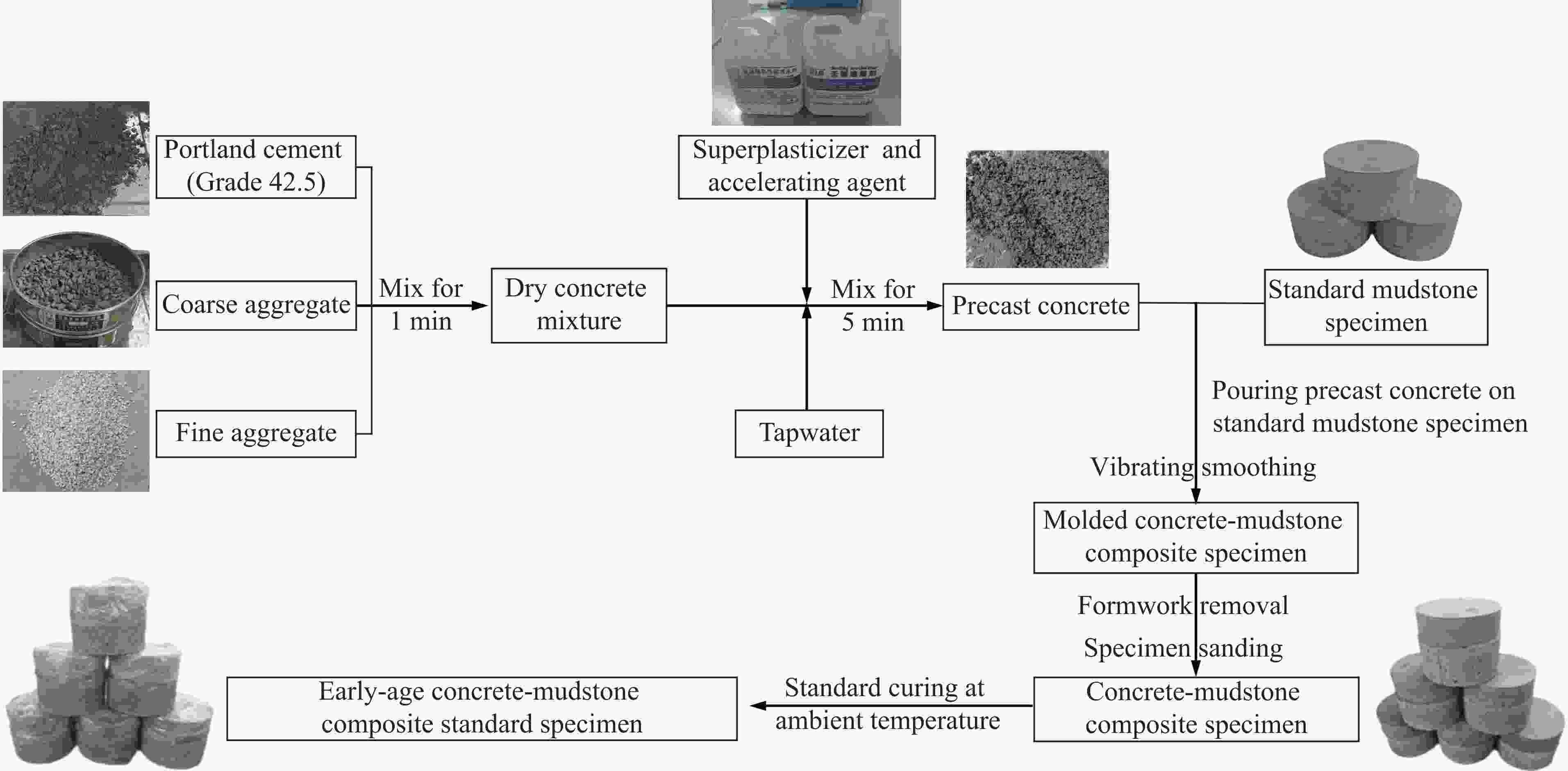
 下载:
下载:
